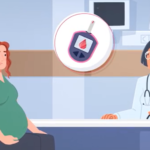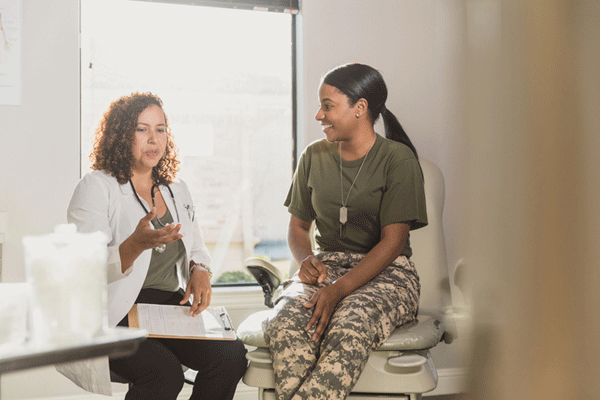Katie* entered the Marine Corps in prime physical condition.She was a Division 1 college athlete who rowed crew and she sailed through military officer training and passed PTs with ease. But about 10 years into her military career, her first pregnancy caused pelvic floor damage that never fully healed. Her efforts to return to physical training and get back within Marine Corps weight standards within six months after childbirth put more stress on her body. Ultimately, her pelvic floor injury caused chronic back and hip pain, limiting her ability to participate in some physical activities and forcing her to seek out a team of medical providers for pain management.
“Your body gets in this whole cycle where … you’re constantly in pain, but [you think that] maybe it’s just my nerves that are just stuck in this pattern,” Katie said. “Because for so long, the pain went untreated.”
While roughly 30% of female military veterans report experiencing chronic pelvic pain, up to double the overall rate for civilian women of childbearing age, there is no specific aspect of combat deployment or military training that directly leads to pelvic pain and underlying uterine conditions, said Shea O’Neill, M.D., an OB-GYN specialist working at the Naval Medical Center San Diego. Rather, she said, these events can cause the stress and trauma that then trigger a physical response.
Watch: Reducing Pelvic Pain in Servicewomen >>
“Deployments are difficult — war is difficult. Being involved in combat is difficult,” O’Neill said. “Any kind of trauma is going to be reflected in your menstrual health.”
Detective work
In her position, O’Neill sees nearly all of the servicewomen and service members assigned female at birth (AFAB) seeking treatment at the medical center who report pelvic pain. Her work, she said, requires her to be a detective. To find the source of pain, she has to ask questions about her patients’ histories and connect their symptoms not only to recent trauma, but also to past unresolved events that may be preventing healing and recovery. For example, conversations with patients may begin with discussion of a recent traumatic event, like a sexual assault, but later reveal an unprocessed earlier trauma, like the death of a parent during childhood, that can be traced to initial physical symptoms.
That’s because trauma and the stress it causes are closely linked with many kinds of pelvic pain, O’Neill said. In the same way that other bodily conditions — such as chronic lower back pain, acid reflux and grinding teeth at night — are understood to be stress responses, ongoing pelvic pain without a clear source is likely to be a stress response as well.
“Women carry tension in their pelvis,” O’Neill said. “If you have heavy, painful periods, that means something’s wrong. If you have pelvic pain, that means something’s wrong.”
Barriers to treatment and the pain gap
A major barrier to diagnosis and treatment is a lack of understanding of the linkage between pain and trauma — and the reality that pelvic pain of any kind — including pain during and after sexual intercourse — is not normal, O’Neill said. She said that many service members AFAB seeking treatment for pelvic pain at military medical facilities like the one where she works are addressing long-standing problems that may even date from before they entered service. Military service members are much more likely to have experienced traumatic events in childhood than civilians, and female troops are more likely to report these harmful childhood experiences than their male counterparts.
Women also face a “pain gap”: They’re less likely to be diagnosed and treated for both acute and chronic pain. While the military medical system still falls short in providing adequate and flexible care for servicewomen and service members AFAB, O’Neill noted that military service may represent the first time some women have access to regular healthcare.
Not all pelvic and uterine conditions are created equal. For example, amenorrhea, or the absence of a normal period, can be caused by excessive exercise. This is a particular risk for service members AFAB during intense military physical training, or when a person is significantly underweight or overweight. On the other hand, menorrhagia, or heavy menstrual bleeding that lasts more than seven days, is more likely to be trauma-informed, O’Neill said. While most cases of menorrhagia can be linked to hormone imbalances and treated by prescribing birth control pills, O’Neill said, the condition can also point to stress-induced menstrual cycle disruption.
Uterine fibroids, noncancerous growths in the uterus, typically don’t require treatment unless they flare up and cause pain and heavy bleeding. Stress that causes rising hormone levels has been linked to fibroid growth.
Links between sexual trauma and chronic pain
While pelvic pain can be a physical response to a variety of physical and emotional stressors, it’s also commonly linked to military sexual trauma (MST). Data from the Department of Veterans Affairs (VA) shows that veterans who have experienced MST, combat trauma or post-traumatic stress disorder (PTSD) are up to three times more likely to live with chronic pelvic pain than veterans without these experiences. According to the VA, 1 in 3 female veterans report experiencing MST, which raises the risk of developing PTSD and other stress-response symptoms.
Know the signs: PTSD symptoms
- Anxiety, agitation or jumpiness
- Tendency to minimize symptoms
- Unwillingness to commit to ongoing medical care and tendency to cancel appointments
- Extreme quietness or withdrawal during appointment
- Crying without a clear cause
Even in the cases where MST involves physical trauma, O’Neill said the right treatment for survivors, including speaking with medical providers who believe them and validate their experiences, can reduce the chances they’ll experience chronic physical pain as a result. In her experience, O’Neill said, women who develop symptoms of PTSD are more likely to develop chronic pelvic pain as well — further evidence of the close link between psychological stress and physical symptoms.
The most important thing medical providers can do is to believe women who report sexual assault and offer them an opportunity to process the trauma in an environment that feels safe, rather than forcing them to suppress trauma and let it get worse. It’s also important to refer them to mental health services as part of the treatment plan.
“Military sexual trauma becomes a huge issue when somebody does report it and they are not believed, not cared for,” she said.
Katie said she gives service members AFAB similar advice now when it comes to all pelvic pain: Seek help, and don’t stop until you find the care solutions you need.
*Katie is not her real name.
This educational resource was created with support from Sumitomo Pharma.















